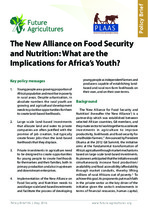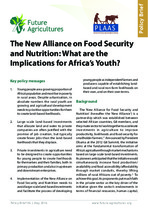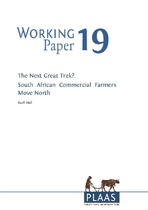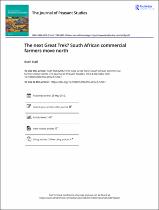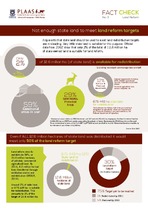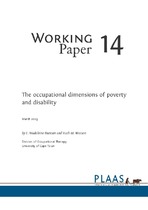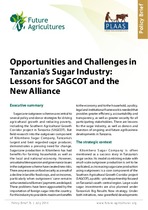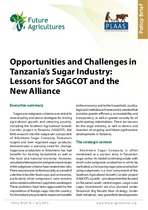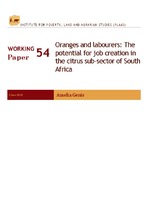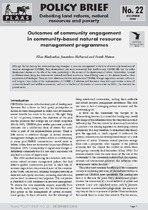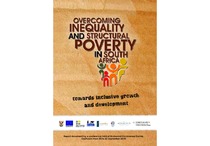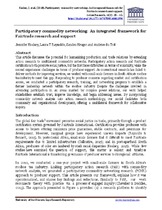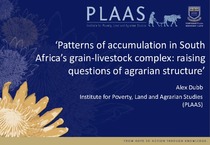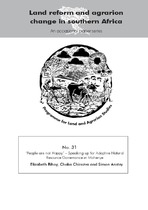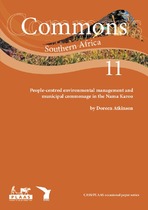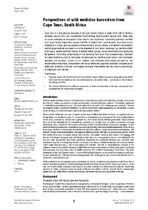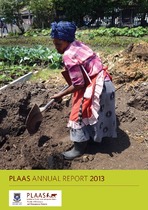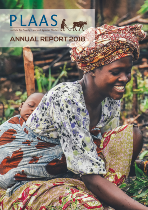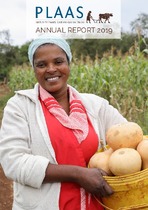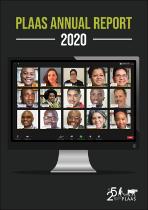Browsing Institute for Poverty, Land and Agrarian Studies (PLAAS) by Title
Now showing items 366-385 of 608
-
The New Alliance on Food Security and Nutrition: What are the Implications for Africa’s Youth?
(Institute for Poverty Land and Agrarian Studies (PLAAS), 2016)The ‘New Alliance for Food Security and Nutrition’ (hereafter the ‘New Alliance’) is a partnership which was established between selected African countries, G8 members, and the private sector to ‘work together to accelerate ... -
The new alliance on food security and nutrition: what are the implications for Africa’s youth?
(Future Agricultures Consortium, 2016)Young people are a growing proportion of Africa’s population and most live in poverty in rural areas. Despite urbanisation, in absolute numbers the rural youth are growing and agricultural development needs to prioritise ... -
The next great trek? South African commercial farmers move north
(Institute for Poverty, Land and Agrarian Studies, University of the Western Cape, 2011)This paper analyses the shifting role of South African farmers, agribusiness and capital elsewhere in southern Africa and the rest of the continent. It explores recent expansion trends, investigates the interests and agendas ... -
The next great Trek? South African commercial farmers move north
(Taylor and Francis Group, 2012)This paper analyses the shifting role of South African farmers, agribusiness andcapital elsewhere in the Southern African region and the rest of the continent. Itexplores recent trends in this expansion, and investigates ... -
Not enough state land to meet land reform targets
(Institute for Poverty Land and Agrarian Studies (PLAAS), 2013)Arguments that state land should be used to meet land redistribution targets are misleading. Very little state land is suitable for this purpose. Official data from 2002 show that only 2% of the total of 12.6 million ha ... -
The occupational dimensions of poverty and disability
(Institute for Poverty, Land and Agrarian Studies, University of the Western Cape, 2009-03)This paper is based on ongoing research into the form, performance and meaning of all the things that particularly vulnerable people do every day i.e. their occupations. Occupations are the building blocks for livelihood. ... -
Opportunities and challenges in Tanzania’s sugar industry: Lessons for SAGCOT and the New Alliance
(Institute for Poverty, Land and Agrarian Studies, University of the Western Cape, 2014)Sugarcane outgrower schemes are central to several policy and donor strategies for driving agricultural growth and reducing poverty, including the Southern Agricultural Growth Corridor project in Tanzania (SAGCOT). But ... -
Opportunities and challenges in Tanzania’s sugar industry: Lessons for SAGCOT and the New Alliance
(Institute for Poverty Land and Agrarian Studies (PLAAS), 2014)Sugarcane outgrower schemes are central to several policy and donor strategies for driving agricultural growth and reducing poverty, including the Southern Agricultural Growth Corridor project in Tanzania (SAGCOT). But ... -
Oranges and labourers: The potential for job creation in the citrus sub-sector of South Africa
(Institute for Poverty, Land and Agrarian Studies, University of the Western Cape, 2018-06)Rural employment is a key policy issue in South Africa, yet the National Development Plan (NDP) of 2012 suggests that one million jobs can be created in agricultural production, processing and related activities. The plan ... -
Outcomes of community engagement in community-based natural resource management programmes
(Institute for Poverty, Land and Agrarian Studies, University of the Western Cape, 2006)Although the last century has witnessed exciting strategies in resource management in the form of community-based natural resource management (CBNRM), these developments are more incremental than revolutionary. CBNRM falls ... -
Overcoming inequality and structural poverty in South Africa
(Institute for Poverty Land and Agrarian Studies (PLAAS), 2010)Data indicates that between 1994 and 2008 poverty in South Africa declined marginally, but that inequality continues to increase, and the full impact of the rise in unemployment following the global financial crisis has ... -
Participatory commodity networking: An integrated framework for Fairtrade research and support
(SAGE Publications, 2018)This article discusses the potential for humanizing production and trade relations by extending action research to multilateral commodity networks. Participatory action research and Fairtrade certification both promote ... -
Patterns of accumulation in South Africa’s grain-livestock complex: raising questions of agrarian structure
(2017)• What is the grain-livestock ‘complex’ (GLC)?: – ‘Complex’ rests on the key linkage between maize and soya key inputs and central cost ingredients in production of feed for intensive livestock production (pigs, chickens ... -
‘People are not happy’ – Speaking up for adaptive natural resource governance in Mahenye
(Institute for Poverty Land and Agrarian Studies (PLAAS), 2007)This paper explores the ongoing events surrounding the CAMPFIRE project of Mahenye in Zimbabwe within the context of the recent discourse of crisis within community based natural resource management (CBNRM) and crisis ... -
People-centred environmental management and municipal commonage in the Nama Karoo
(Institute for Poverty Land and Agrarian Studies (PLAAS), 2005)Land reform is a key part of government policy, spurred politically by the claims of the landless, as well as the land reform pressures in countries like Zimbabwe. It is clear to national and provincial governments that ... -
Perspectives of wild medicine harvesters from Cape Town, South Africa
(Academy of Science of South Africa and AOSIS, 2017)Cape Town is a fast-growing cityscape in the Cape Floristic Region in South Africa with 24 formally protected conservation areas including the World Heritage Table Mountain National Park. These sites have been protected ... -
PLAAS annual report 2013
(Institute for Poverty Land and Agrarian Studies (PLAAS), 2014)This Act is most commonly associated with the consolidation of the colonial ‘land grab’, which had gathered force during the previous 200 years, and with helping to create the framework for the infamous ‘Black Spot ... -
PLAAS Annual Report 2018
(PLAAS, 2019-08)PLAAS had a busy 2018. With the land reform debate catapulted into the public sphere, new teaching initiatives, and various research projects and outputs, our team had quite a year. We had a successful and productive year. ... -
PLAAS Annual Report 2019
(PLAAS, 2020-12-01)PLAAS had a successful 2019, contributing effectively to the University of the Western Cape’s mission as a research-led, community-oriented and engaged university. -
PLAAS Annual Report 2020
(Institute for Poverty Land and Agrarian Studies (PLAAS), 2021)In our previous Annual Report, I remarked that 2019 seemed to be a year of the gathering storm. Little did we know what was coming. As we looked forward to 2020, we knew that it was going to be a significant year. For one ...

